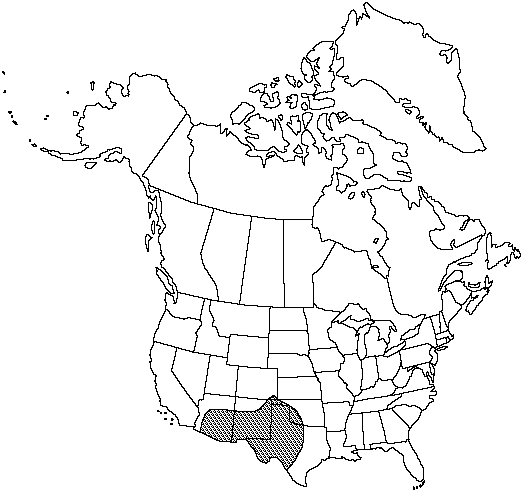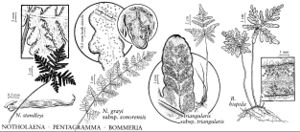Difference between revisions of "Notholaena standleyi"
Amer. Fern J. 5: 1. 1915.
FNA>Volume Importer |
imported>Volume Importer |
||
| (5 intermediate revisions by 2 users not shown) | |||
| Line 6: | Line 6: | ||
|place=5: 1. 1915 | |place=5: 1. 1915 | ||
|year=1915 | |year=1915 | ||
| + | }} | ||
| + | |special_status={{Treatment/ID/Special_status | ||
| + | |code=F | ||
| + | |label=Illustrated | ||
}} | }} | ||
|basionyms= | |basionyms= | ||
| Line 11: | Line 15: | ||
|name=Cheilanthes standleyi | |name=Cheilanthes standleyi | ||
|authority=(Maxon) Mickel | |authority=(Maxon) Mickel | ||
| + | |rank=species | ||
}} {{Treatment/ID/Synonym | }} {{Treatment/ID/Synonym | ||
|name=Chrysochosma hookeri | |name=Chrysochosma hookeri | ||
|authority=(Domin) Kümmerle | |authority=(Domin) Kümmerle | ||
| + | |rank=species | ||
}} {{Treatment/ID/Synonym | }} {{Treatment/ID/Synonym | ||
|name=Notholaena hookeri | |name=Notholaena hookeri | ||
|authority=D. C. Eaton | |authority=D. C. Eaton | ||
| + | |rank=species | ||
}} | }} | ||
|hierarchy=Pteridaceae;Notholaena;Notholaena standleyi | |hierarchy=Pteridaceae;Notholaena;Notholaena standleyi | ||
| Line 41: | Line 48: | ||
-->{{#Taxon: | -->{{#Taxon: | ||
name=Notholaena standleyi | name=Notholaena standleyi | ||
| − | |||
|authority=Maxon | |authority=Maxon | ||
|rank=species | |rank=species | ||
| Line 55: | Line 61: | ||
|publication title=Amer. Fern J. | |publication title=Amer. Fern J. | ||
|publication year=1915 | |publication year=1915 | ||
| − | |special status= | + | |special status=Illustrated |
| − | |source xml=https:// | + | |source xml=https://bitbucket.org/aafc-mbb/fna-data-curation/src/2e0870ddd59836b60bcf96646a41e87ea5a5943a/coarse_grained_fna_xml/V2/V2_705.xml |
|genus=Notholaena | |genus=Notholaena | ||
|species=Notholaena standleyi | |species=Notholaena standleyi | ||
Latest revision as of 20:24, 5 November 2020
Stem scales strongly bicolored, margins brown, broad and well defined, thin, entire. Leaves 5–30 cm. Petiole brown, equal to or somewhat longer than blade, rounded adaxially, glabrous except for a few scales at base. Blade broadly pentagonal, deeply pinnatifid but not fully pinnate above base (distal pinnae connected by narrow wing of green tissue), 1–2 times longer than wide, abaxially with conspicuous yellowish farina, scales absent, adaxially glabrous; basal pinnae much larger than adjacent pair, strongly inequilateral, proximal basiscopic pinnules greatly enlarged. Ultimate segments sessile, broadly adnate to costae; segment margins slightly recurved, rarely concealing sporangia. Sporangia containing 32 or 16 spores. 2n = 60.
Phenology: Sporulating late spring–fall.
Habitat: Rocky slopes and cliffs, on a variety of substrates including granite and limestone
Elevation: 300–2100 m
Distribution

Ariz., Colo., N.Mex., Okla., Tex., Mexico.
Discussion
The low numbers of spores per sporangium in Notholaena standleyi are apparently not associated with apogamy because all plants thus far analyzed are sexual diploids (M. D. Windham, unpublished data). D. S. Siegler and E. Wollenweber (1983) identified three chemotypes in this species correlated with substrate specificity and subtle variations in farina color. These three "races" occupy different portions of the geographic range, and further investigation may indicate that they deserve formal taxonomic recognition. A report of Notholaena standleyi from Nevada (D. B. Lellinger 1985) must be considered suspect because it is disjunct, and the closest populations in Arizona represent a different chemotype.
Selected References
None.
